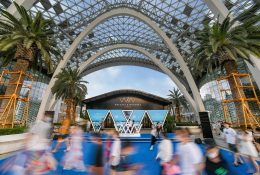While the Chinese property developer Evergrande labours under a colossal $260 billion debt, the island of Hainan carries on oblivious. Month after month, this island and southernmost province confirms its status as China’s new luxury hotspot. Official figures in the wake of Golden Week – seven days of holiday to celebrate National Day which this year ran from October 1st to 7th — speak for themselves. Whereas tourism revenue generated by the 515 million trips made within the country amounted to “just” $60 billion, down 4.7% on 2020, sales registered by Hainan’s nine duty-free shopping malls totalled $252 million, leaping 75% on 2020 and 359% on 2019. The immense popularity of this duty-free paradise for luxury shopping is reason enough for Watches and Wonders to host its second edition at the Sanya International Duty Free Shopping Complex, where 14 brands have their pavilions in marquees opposite the main entrance, from October 1st to December 31st.
Growth on the cards
There is nothing fortuitous about the stellar growth of this Chinese Hawaii, as the island is often called. Its transformation into a giant tropical shopping mall is the result of a government plan to make Hainan the biggest free trade port in the world, supported by a range of policies and incentives such as a reduction in tax rates and a relaxing of visa requirements. In addition, visitors are now allowed to spend up to $15,000 during their stay and can continue to purchase duty-free products online for six months after returning home. Better still, as from 2025 the entire island will be designated a duty-free zone, hence brands will no longer have to collaborate with duty-free licence holders.
The government’s five-year plan estimates that Hainan’s duty-free market will grow tenfold by 2025 to reach $46.4 billion.
In the meantime, Hainan’s growth is unlikely to slow. Chinese international air travel isn’t expected to return to pre-Covid-19 levels for another two to three years, which leaves the island ideally placed to absorb Chinese tourism and the demand for luxury goods that goes with it. Already last year, Chinese visitors to the island spent twice as much — $4.3 billion — on duty-free as they did the previous year. The province’s government expects this figure to exceed $9 billion in 2021. At this rate, and according to the Hainan provincial government’s five-year plan, the duty-free market will grow tenfold between now and 2025 to reach $46.4 billion. A survey by Bain & Co and Atlagamma reports that Chinese consumers accounted for 35% of the global luxury spend in 2019 yet only 11% of these purchases were made domestically. Within the next four years, this figure should be nearer to 30% with Hainan in the front line to benefit. A further relaxing of rules should provide an additional boost, combined with increased investment by brands and local developers who plan to double mall capacity over the coming four years. Price competitiveness is an additional factor, with products costing between 20% and 30% less than on the domestic market even before further discounts.
A word of warning
In its report on Hainan, “the new battleground for global luxury,” McKinsey sets out three points which luxury brands tempted by the Hainan experience should bear in mind. Firstly, the duty-free model, which is optimised for volume sales at significantly discounted prices, can damage brand equity. Secondly, differences in pricing between Hainan and the mainland puts brands at risk of cannibalising their domestic business in China and eroding margins in the long term. Thirdly, the volume-based sales model also makes it harder for brands to build customer relationships. “The response of some luxury brands has been to actively limit their presence on the island or to refrain from opening a presence entirely,” writes McKinsey. “However, with Hainan growing fast to take an increasingly significant share of the Chinese luxury market, and slated to become a fully duty-free island province by 2025, it is imperative that luxury brands formulate a strategy to enter, operate, and scale in the market.”
It is imperative that luxury brands formulate a strategy to operate and scale in Hainan. - McKinsey
Watches and Wonders is an excellent illustration as it gives visitors the opportunity to familiarise themselves with the different aspects of watchmaking excellence through demonstrations at the workbench. Other highlights include a deep-dive into the history of iconic watches, analyses of the latest market trends and explanations of complications, in addition to the many activations offered by the participating brands. A reminder that watchmaking is an entire world and not simply a question of price.




















